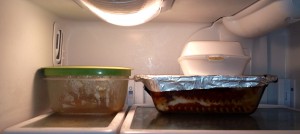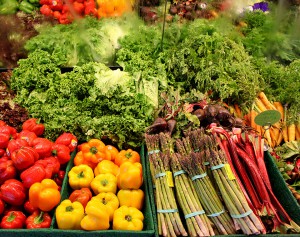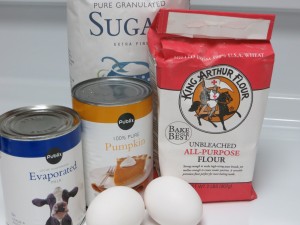
by Ricki McWilliams | Dec 11, 2014
 Being sick during the holiday season is no fun. Did you know the flu is not the only thing that can have you feeling under the weather? The Centers for Disease Control and Prevention (CDC) estimate that each year roughly 1 in 6 Americans (or 48 million people) get sick, 128,000 are hospitalized, and 3,000 die of foodborne diseases (CDC, 2014). This holiday season, UF/IFAS Extension Agents will be available to help keep you and the ones you care about safe by reminding you of the United States Department of Agriculture ‘s four steps to safer food handling this holiday season:
Being sick during the holiday season is no fun. Did you know the flu is not the only thing that can have you feeling under the weather? The Centers for Disease Control and Prevention (CDC) estimate that each year roughly 1 in 6 Americans (or 48 million people) get sick, 128,000 are hospitalized, and 3,000 die of foodborne diseases (CDC, 2014). This holiday season, UF/IFAS Extension Agents will be available to help keep you and the ones you care about safe by reminding you of the United States Department of Agriculture ‘s four steps to safer food handling this holiday season:
- Wash your hands and your cooking surfaces before you start, when you will touch different foods, and after you finish preparing a dish.
- Separate cooked foods and ready-to-eat foods from foods that still need to be prepared.
- Always cook and reheat your foods to above 140 degrees Fahrenheit.
- Chill your leftovers. Don’t let your dishes sit out without refrigerating or keeping them heated. Throw out foods that have been between 40 degrees and 140 degrees Fahrenheit for more than 2 hours.
Have a question that is not related to food safety, like:
- How do I make a brine for my turkey?
- I ran out of eggs – is there a substitute?
- I couldn’t find any buttermilk. What do I do?
…Don’t worry – call the UF/IFAS Extension Northwest District Family and Consumer Sciences (FCS) HOLIDAY FOOD HOTLINE. Northwest District FCS agents will be available 8am – 8pm CST/9 am – 9pm EST by calling 850-888-2412 (December 15 – January 1) to assist you with food preparation, food safety, or any other kitchen concerns you may have.
The best part is you can always count on UF/IFAS Extension to provide you with research-based information!
Holiday Food Hotline
850-888-2412
References:
Centers for Disease Control and Prevention (2014). “Estimates of Foodborne Illness in the United States” retrieved December 11, 2014 from http://www.cdc.gov/foodborneburden/
United States Department of Agriculture (2014). “Check Your Steps: Food Safe Families” retrieved December 11, 2014 from http://www.fsis.usda.gov/wps/portal/fsis/topics/food-safety-education/featured-campaign
by Ricki McWilliams | Nov 13, 2014
 There is a time limit on leftovers.
There is a time limit on leftovers.
While leftovers can be a lifesaver for figuring out lunch the next day or dinner when you’re in a time crunch, it is important to remember safe food handling practices including eating, freezing or tossing out refrigerated leftovers within 3-4 days.
Limits to leftovers
Put leftovers in the refrigerator as soon as possible; make sure your refrigerator temperature is 40o F or colder. When possible, label your leftovers with a date and eat within 4 days. If you want to enjoy your leftovers longer than 4 days, transfer them to the freezer. TIP: When placing hot foods directly in the refrigerator, separate the food into small, shallow containers. This allows the food to cool more quickly.
Storage for Leftover Foods – Best Quality
| Product |
Refrigerator (40o F) |
Freezer (0o F) |
| Eggs: |
| Casserole, quiche, omelet |
3-4 days |
2 months |
| Hard-cooked |
1 weeks |
Do not freeze |
| Soups & Stews: |
| Vegetables |
3-4 days |
2-3 months |
| Meat added |
1-2 days |
2-3 months |
| Meat Leftovers: |
| Cooked meat & meat dishes |
3-4 days |
2-3 months |
| Gravy & meat broth |
1-2 days |
2-3 months |
| Cooked Poultry |
| Fried Chicken, plain pieces, cooked poultry dishes |
3-4 days |
4 months |
| Pieces, with broth/gravy |
1-2 days |
6 months |
| Chicken nuggets, patties |
1-2 days |
1-3 months |
| Cooked Seafood: |
| Fish |
3-4 days |
3 months |
| Crab |
1-2 days |
3 months |
| Shrimp |
3-4 days |
2 months |
Fight Bacteria
Follow these four safe food handling practices to keep your foods safe from bacteria:
- Clean: Wash surfaces and hands before and after handling food products.
- Separate: Keep foods separate and don’t cross-contaminate.
- Cook: Cook and reheat food to at least 165o F (gravy, soups, and sauces should be reheated to a boil). Measure temperatures with a food thermometer.
- Chill: Bacteria grow quickly between 41o F and 140o F. Keep your food out of the danger zone by refrigerating it promptly.
For additional food safety information, contact your local UF/IFAS Extension Faculty member in your area.
Sources:
Partnership for Food Safety Education. www.fightbac.org
USDA Food Safety and Inspection Service. August 2013. Basics for Handling Food Safely. http://www.fsis.usda.gov/wps/portal/fsis/topics/food-safety-education/get-answers/food-safety-fact-sheets/safe-food-handling/basics-for-handling-food-safely/
by Ginny Hinton | Mar 17, 2014

Moderation is the key with both sugar and sugar substitutes.
Do you use sugar, honey, artificial sweetener, or some combination of them all? Which are better to use? The internet is flooded with myths about sweeteners – both nutritive and low- or no-calorie. Because it’s often difficult to sift through the claims, here’s a quick primer on sweeteners:
There are two types of sugar in American diets. Naturally occurring sugars are found in milk and fruit. Added sugars include any sweeteners with calories that are added to foods or beverages during preparation. One of today’s biggest culprits for added sugar is carbonated soda. Because added sugars contribute extra calories with zero nutrients, the American Heart Association recommends that everyone try to limit the amount of added sugars in their diet. One way to do that is by using artificial sweeteners.
Artificial or non-nutritive sweeteners are often used for weight control or diabetes management. Because they aren’t carbohydrates, these sweeteners don’t raise blood sugar levels. Approved non-nutritive sweeteners have to pass rigorous government safety assessments before being accepted for sale. They can be safely consumed by the general public and do not cause or increase the risk of cancer or other health conditions. They may help with weight management when used as part of a sensible meal plan. Many rigorous studies support the safety of various non-nutritive sweeteners, including over 200 studies on aspartame alone.
High fructose corn syrup is a sweetener made from corn starch. It has the same calories per tablespoon and very similar effects on blood levels as sugar. Honey is a caloric, or nutritive, sweetener that is often promoted as a healthier option than table sugar or sugar substitutes. Its vitamin and mineral content is actually very similar to sugar and both sugar and honey end up in the body as glucose and fructose.
The bottom line is that moderation is the key with both sugar and sugar substitutes. It’s important with sweeteners to look beyond the hype. In the end any processed foods, with or without sugar substitutes, generally don’t offer the same health benefits you get from foods like fruits and vegetables.
References:
Mayo Clinic Staff, Artificial Sweeteners and Other Sugar Substitutes (October 9, 2012). http://www.mayoclinic.com/health/artificial-sweeteners?MY00073
Junod, Suzanne W., Sugar: A Cautionary Tale (May 21,2009). http://www.fda.gov.
CFSAN/Office of Food Additive Safety, FDA Statement on European Aspartame Study (April 20, 2007). http://www.fda.gov
International Food Information Council Foundation, Facts About Low-Calorie Sweeteners, (August 2012). www.foodinsight.org.
American Diabetes Association, Artificial Sweeteners (February 16, 2011). www.diabetes.org/food-and-fitness/
Food and Drug Administration, High Fructose Corn Syrup: Questions and Answers (April 17, 2013). http://www.fda.gov
Hirsch, Larissa, Are Artificial Sweeteners OK to Consume During Pregnancy? (August 2009). http://kidshealth.org
Low Calorie Sweeteners Webinar powerpoint (2011). https://connect.extension.iastate.edu/fffcop?launcher=false.
American Heart Organization, Non-Nutritive Sweeteners (Artificial Sweeteners) (December 13, 2012). http://www.heart.org?HEARTORG
by Heidi Copeland | Mar 3, 2014

Handle food safely and stay informed about food recalls.
Have you paid attention to any of the recent food recalls? In February 2014, both the U.S. Food and Drug Administration (FDA) and the U. S. Department of Agriculture (USDA) issued consumer food recalls and alerts for a variety of food safety reasons. Product recalls warned consumers about undeclared allergens, false or misleading labeling, pathogenic contamination, and unsanitary processing conditions, to name only a few of the reasons.
A safe food supply is important to everyone! Both the USDA and the FDA have responsibility for protecting different segments of the food supply however; there are other food safety agencies involved. Consumers play an important part in keeping food safe. In addition, to handling food safely, consumers need to be aware of food recalls. Watch for food recall notices in the news, at your local grocery store, and online at www.recalls.gov. If identifying marks on the food product you have purchased match the detailed information in the recall notices, then you can do the following:
- Return the product to the place of purchase for a refund. OR Dispose of the product following the instructions provided in the recall notice to assure it will not be consumed by anyone.
- Do not eat the product.
- Dispose of the product carefully.
- Do not give the product to others (do not give to food bank, your pet, for example).
- Do not puncture or otherwise open cans.
- Wash hands with warm water and soap for at least 20 seconds after handling the product.
The Bottom Line is… if you sense there’s a problem with any food product, don’t consume it. “When in doubt, throw it out!”
Share this educational information with family, friends, and neighbors. Stay informed, stay safe; check for product recalls.
View the following UF/IFAS Extension publications for more information about food regulation”
http://edis.ifas.ufl.edu/pdffiles/FS/FS12100.pdf
http://edis.ifas.ufl.edu/pdffiles/FS/FS11800.pdf
by Marjorie Moore | Nov 5, 2013

Store homemade pumpkin pies in the refrigerator.
To refrigerate pumpkin pies or not to refrigerate? That is the question. You have seen pumpkin pies in the bakery section of supermarkets not refrigerated and you wonder if you can do the same at home. Unfortunately, homemade pumpkin pies need special care to prevent foodborne illness. Pumpkin pies are a custard-style pie made by using potentially hazardous foods such as eggs and milk. Food temperature controls are especially important with foods classified as potentially hazardous.
Pumpkin pies also have a high moisture and protein content. They must be kept at a refrigerated temperature of 41° F or cooler. If the pies are left out of the refrigerator for more than 2 hours, bacteria grows more rapidly and can cause a foodborne illness.
When cooking, make sure to test your pies for doneness by inserting a clean knife in the center. The knife should come out clean. Remove the pies from the oven and allow them to cool at room temperature for about 30 minutes. After they have cooled, cover and refrigerate to keep them cold.
So, why are pumpkin pies displayed at room temperature at the supermarket? These pies are formulated with shelf-stable ingredients, such as preservatives, that prevent harmful bacteria from growing. Commercial pies must be properly labeled, “approved by the Food and Drug Administration”. They will carry the letters “RT”, which means they meet the guidelines required for display at room temperature. The label will also give a “sell by” or “use by” date. Even these pies should be refrigerated for storage at home especially after they have been cut.
Additional pie safety tips include making sure you purchase clean, refrigerated and uncracked eggs. Keep hands clean by washing them with warm water and soap before handling ingredients. Also, wash utensils, equipment and work surface area with hot soapy water before and after contact with eggs. Never leave milk or eggs out of the refrigerator for more than two hours.
Enjoy those traditional holiday feasts, but keep them safe!

 Being sick during the holiday season is no fun. Did you know the flu is not the only thing that can have you feeling under the weather? The Centers for Disease Control and Prevention (CDC) estimate that each year roughly 1 in 6 Americans (or 48 million people) get sick, 128,000 are hospitalized, and 3,000 die of foodborne diseases (CDC, 2014). This holiday season, UF/IFAS Extension Agents will be available to help keep you and the ones you care about safe by reminding you of the United States Department of Agriculture ‘s four steps to safer food handling this holiday season:
Being sick during the holiday season is no fun. Did you know the flu is not the only thing that can have you feeling under the weather? The Centers for Disease Control and Prevention (CDC) estimate that each year roughly 1 in 6 Americans (or 48 million people) get sick, 128,000 are hospitalized, and 3,000 die of foodborne diseases (CDC, 2014). This holiday season, UF/IFAS Extension Agents will be available to help keep you and the ones you care about safe by reminding you of the United States Department of Agriculture ‘s four steps to safer food handling this holiday season:



